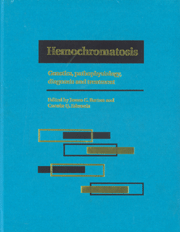Book contents
- Frontmatter
- Contents
- List of contributors
- Foreword
- Part I Introduction to hemochromatosis
- Part II Genetics of hemochromatosis
- Part III Metal absorption and metabolism in hemochromatosis
- Part IV Diagnostic techniques for iron overload
- Part V Complications of iron overload
- 21 Mechanisms of iron toxicity
- 22 Iron as a carcinogen
- 23 Clinical spectrum of hepatic disease in hemochromatosis
- 24 The arthropathy of hemochromatosis
- 25 Diabetes mellitus and hemochromatosis
- 26 Non-diabetic endocrinopathy in hemochromatosis
- 27 Cutaneous manifestations of hemochromatosis
- 28 Cardiac abnormalities in hemochromatosis
- 29 Estimate of the frequency of morbid complications of hemochromatosis
- 30 Juvenile hemochromatosis
- Part VI Therapy of hemochromatosis and iron overload
- Part VII Infections and immunity in hemochromatosis
- Part VIII Hemochromatosis heterozygotes
- Part IX Relationship of hemochromatosis to other disorders
- Part X Animal models of hemochromatosis and iron overload
- Part XI Screening for hemochromatosis
- Part XII Hemochromatosis: societal and ethical issues
- Part XIII Final issues
- Index
23 - Clinical spectrum of hepatic disease in hemochromatosis
from Part V - Complications of iron overload
Published online by Cambridge University Press: 05 August 2011
- Frontmatter
- Contents
- List of contributors
- Foreword
- Part I Introduction to hemochromatosis
- Part II Genetics of hemochromatosis
- Part III Metal absorption and metabolism in hemochromatosis
- Part IV Diagnostic techniques for iron overload
- Part V Complications of iron overload
- 21 Mechanisms of iron toxicity
- 22 Iron as a carcinogen
- 23 Clinical spectrum of hepatic disease in hemochromatosis
- 24 The arthropathy of hemochromatosis
- 25 Diabetes mellitus and hemochromatosis
- 26 Non-diabetic endocrinopathy in hemochromatosis
- 27 Cutaneous manifestations of hemochromatosis
- 28 Cardiac abnormalities in hemochromatosis
- 29 Estimate of the frequency of morbid complications of hemochromatosis
- 30 Juvenile hemochromatosis
- Part VI Therapy of hemochromatosis and iron overload
- Part VII Infections and immunity in hemochromatosis
- Part VIII Hemochromatosis heterozygotes
- Part IX Relationship of hemochromatosis to other disorders
- Part X Animal models of hemochromatosis and iron overload
- Part XI Screening for hemochromatosis
- Part XII Hemochromatosis: societal and ethical issues
- Part XIII Final issues
- Index
Summary
Introduction
Due to its direct connections to the intestinal tract, the liver is the first target organ of hemochromatosis. In this respect, it plays a key role in accumulating iron absorbed by the intestine. This storage function has two main consequences: first, it exerts a relative protective effect over other organs second, longstanding and massive iron excess can induce damage of the liver that may lead to the development of fibrosis, cirrhosis, and hepatocellular carcinoma. The clinical spectrum of hepatic disease in hemochromatosis is therefore particularly broad, ranging from silence to extreme severity. In addition, this expression can be modulated by various coexisting factors and coincidental hepatic disorders. The diagnosis of hepatic disease in persons with hemochromatosis needs a careful differential approach due to the characteristics of newly described hepatic iron overload syndromes. Finally, the response of these hepatic disorders to treatment (i.e., therapeutic phlebotomy) depends on the stage of hepatic damage.
The clinical expression of the hemochromatosis liver
The ‘silent’ liver
Today, this is often the status of the liver in persons with hemochromatosis. In most patients, particularly those <30 years of age, the liver is clinically silent. The clinical examination is negative, there is no detectable hepatomegaly, and hepatic function tests are normal. At this stage, the diagnosis of hepatic iron overload can only be made by magnetic resonance imaging (MRI) and hepatic biopsy. However, performing a hepatic biopsy in the absence of either clinical or biochemical signs suggestive of hepatic disease is becoming less usual in patients suspected of having hemochromatosis, and is reserved for patients in whom the diagnosis of hemochromatosis cannot be established by the detection of homozygosity for the HFE mutation C282Y.
- Type
- Chapter
- Information
- HemochromatosisGenetics, Pathophysiology, Diagnosis and Treatment, pp. 250 - 257Publisher: Cambridge University PressPrint publication year: 2000
- 3
- Cited by



